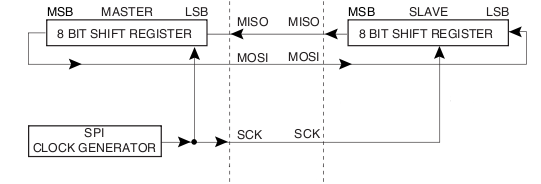Archive for the ‘FAQ’ Category.
25 лютого 2018 3:26 PM
Від публікації огляду відмінностей між «A» і «не-A»-версіями мікроконтролерів AVR пройшло чимало часу і вже давно можна порівнювати «B»-версії. Таких мікроконтролерів ще небагато, але є на що подивитися. Errata на кристали я ще не вивчав, як там буде що важливе — доповню пізніше.
Раніше я вже коротко писав про ATmega48PB…168PB. ATmega328PB і ATmega324PB просунулися набагато далі, це вже практично нові мікроконтролери, сумісні по виводах з «not-B». Для всіх цих мікроконтролерів є спільний, з першого погляду непомітний, але важливий момент — DIP-корпусів більше нема. Тому тим, хто розраховує лише на них, далі можна не читати 😉
З точки зору програматора змінилися лише сигнатури (ідентифікатри) мікроконтролерів та додався один fuse в ATmega328PB і ATmega324PB. Він забороняє нову функцію (CFD, див. нижче) і з заводу запрограмований. Якщо його не треба міняти і якщо можна змусити програматор проігнорувати сигнатуру, то всі ці кристали можна прошивати як відповідні PA. Втім, в avreal ці мікроконтролери вже додано, а для всіх іншіх програматори це, думаю, зроблено давно 🙂
Можливо, цей список і не збільшуватиметься вже, бо анонсовано геть нові ATmega3208/3209/4808/4809 із суттєво збільшеним обсягом оперативної пам’яті (натомість зменшеною EEPROM) та розширеною периферією.
Отже, відмінності… » » »
27 липня 2012 10:50 PM
Sorry, but this post is not available in English
30 січня 2012 11:17 PM
Час від часу зустрічаю запитання по відмінностях між цими мікросхемами. В описах чи відкритих проектах в інтернеті згадується FT2232C, а в продажу зараз є FT2232D. Виникають сумніви у сумісності програм та адаптерів.
Як це часто буває, всі ці сумніви розвіюються при перегляді сторінки опису FT2232D. Але чомусь багатьом легше не подивитися на сайті виробника, а спитати на форумі чи набрати рядок «різниця FT2232C та FT2232D» в пошуковику. Ну що ж, ось він, цей рядок для нього, хай йому буде легше 🙂
Документації на старіші версії мікросхем на сайті вже немає, але безпосередньо на сторінці сказано:
The FT2232D is the 3rd generation of FTDI’s popular USB UART/FIFO IC. The FT2232D is an updated version of the FT2232C and its lead free version, the FT2232L. Please note that the FT2232D is not an new generation of device.
The FT2232D is lead free and pin compatible with the original FT2232C and FT2232L devices. All the original device features are supported with some additional features available including a CPU-style FIFO mode and an extended operating temperature range.
І що ж все це означає? » » »
14 березня 2011 2:54 AM
From AVReAl‘s point of view there are two Windows families.
Windows 9X family OS like Windows 98 does not require LPT access driver. avreal uses direct IO access when working in it.
NT-line OS like Windows XP or Windows 7 requires a DLPortIO driver. Driver installation process for 32-bit and 64-bit OS has been described before.
For all Windows versions parallel port number or base address must be set in command line, for example -p1, -p378. Port number is just alias for standard address as it is noted in -p switch description. Fixed 378/278/3BC addresses are used for LPT1/2/3.
Non-standard base address for PCI-LPT (PCI-Express LPT, PCMCIA-LPT) extension board can be found on port properties tab in device manager.
»»» How to see the address of LPT in Windows XP, Windows 7
3 січня 2011 12:27 PM
Unlike in NT-line Windows a DLPortIO.sys driver is not required for LPT port access in Linux/x86 (both 32- and 64-bit). Unlike in Windows 98 any program in Linux can’t access ports without permissions.
There are two ways — direct IO-port access and parport device usage. Direct access provides faster programming but requires root privileges when avreal is started.
Continue reading ‘avreal and LPT in Linux’ »
16 вересня 2010 2:18 PM
I have answered the question about differences between new “A-version” of tinyAVR/megaAVR mirocontrollers and their predecessors. Now I decided to compare the controllers more detailed from a programmer (as software writer) point of view. It is not an ultimate analysis of the differencies but not only Migration Notes were studied. Also microcontrollers datasheets were compared.
Continue reading ‘“A” and “not-A” AVRs’ »
11 серпня 2010 11:39 PM
Questions about differences between new “A-version” of AVR mirocontrollers and their predecessors often are found in site log. People look for “what is the difference between atmega48p and atmega48pa” or “atmega8a and atmega8 programming distinction”.
The “microcontroller programming” sentence may have different meanings.
Continue reading ‘What is the difference between ATtiny2313A and ATtiny2313?’ »
28 липня 2010 12:15 AM
Everything you wanted to know about,
but were afraid to ask.
As can be found in site log phrase “synchronisation lost” is one of most popular in site search, but no one asks the question in comments.
“synchronisation lost” message means programmer-to-microcontroller communication fault. SPI interconnection between programming adapter and microcontroller works in the same manner as between two microcontrollers.

Continue reading ‘avreal synchronisation lost’ »

 українська
українська english
english